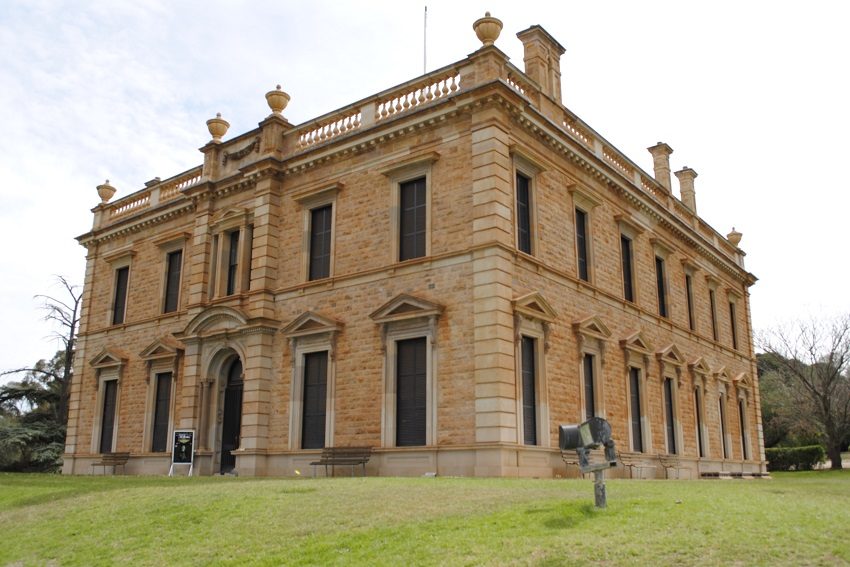Good Country: Mintaro, land of the 'Thin Pharaoh'

From new wave cinema to hedge mazes, South Australia’s other slate capital Mintaro offers many ways to get lost.
After reading an earlier column about Willunga, one Theo Ellenbroek suggested that the Clare Valley’s Mintaro has its own interesting slate history. Theo, you had me at “slate”. And my excitement over exploring another slatey town was not misplaced. Mintaro, snuggled beneath hills of wineries and rosehip bushes, retains many of its original buildings (with several available as B&Bs). Established as a village in 1849, it still feels like a European village. This is reinforced by two distinctive features: the family-friendly hedge (and slate) Mintaro Maze and the very English mansion, Martindale Hall.
Another quirky feature of Mintaro is that its roughly 200 residents pronounce the name of their town differently from outsiders. Before visiting this charming place, I pronounced its name like the first and last part of “Mint-condition Monaro”. But now, I’m saying the word like locals, rhyming Mintaro with “Thin Pharaoh”.
Mintaro was created specifically as a stopover to service the bullock teams and then South American muleteers who transported copper from the Burra copper mines to Port Wakefield along the privately-owned Gulf Road. Despite the prevalence of Spanish-speaking muleteers in the area, the Spanish-sounding Mintaro is more likely to be Indigenous in origin. It is possible, however, that the Chilean and Argentinian muleteers attended mass at the first Jesuit church in Australia (the Jesuits being founded by a Spaniard, St Ignatius). This Church of the Immaculate Conception was built in 1856 on a hill above Mintaro. By 1857, the bullock and mule drivers stopped stopping in Mintaro. Luckily, slate had already been discovered in the region, which ultimately became a game-changer for local industry.

William Morris wallpaper at Martindale Hall
Martindale Hall is the grand 32-room Georgian mansion that was built in 1879-1880 by tradesmen sent from England for the task. The building also employs Mintaro slate inside and out and has William Morris wallpaper that was designed especially for the home. Martindale Hall formerly housed the well-known Adelaide family, the Mortlocks. A fun fact is that Martindale Hall was used in several scenes of Peter Weir’s creepy but classic 1975 film, Picnic at Hanging Rock. This is apt, for Mick Morris, caretaker of Martindale Hall, says that older Mintaro residents used to call the home “House of Sorrow” due to the numerous deaths there.
Mintaro has another movie history claim to fame: it provided settings and cast for an early Russell Crowe film, Hammers over the Anvil (1993). Locals were recruited for some scenes, including Mick Morris. Says Morris, “They took aerials down from buildings and put a cottage on the front of the Magpie and Stump Hotel. In the movie, they changed the pub’s name. I souvenired the sign, and it’s still stored in the shed.” He continues, “Russell didn’t really mingle, but I spoke to [co-star] Charlotte Rampling, and Frankie J. Holden was a top bloke. He shouted the whole bar a beer!”
Martindale Hall stands in for Appleyard College in the original Picnic At Hanging Rock
As well as his brush with Hollywood, Morris was quarry foreman at Mintaro Slate Quarry, the oldest continuous working quarry in Australia, so he knows his way around slate.
What is it that makes Mintaro slate so special – world-renowned even? Morris explains that “Mintaro has the hardest slate in the world. And Mintaro’s one of the few places you can get a piece of slate big enough to make a full billiard table without joints. Normally, the slate in a billiard table has three joints. The company even made a pool table for Lleyton Hewitt”.
Although too diplomatic to weigh into whether Mintaro slate is better than Willunga slate, Morris laughs. “Let’s just say that it’s superior quality slate.”
Mintaro’s slate may be hard, but its residents have softer qualities. As Morris relates, “In times of grief or need, people from Mintaro come out of the woodwork to be supportive. I love the people, the place and the lifestyle. At night, it’s pitch black. No noise. And with the beauty of the surrounding hills, the scenery’s just fantastic.”
That’s a good description of good country (with better than good slate).
